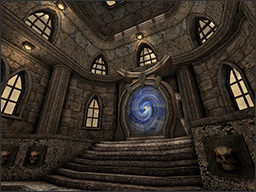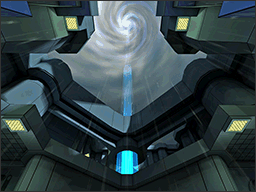|
 |
|
|
|
|
|
|
A year of doing my own projects and travelling to different parts of Europe.
|
 |
|
Map on the Edge of Forever
began life as an experiment into the possibilities of scripting using physical
triggers setup like an old mechanical machine.
The early gameplay prototypes were designed in small box maps and consisted of
a series of puzzle ideas to see what was possible with an modified Q3 engine.
The visual style was developed seperately and was inspired by a summer trip to
Barcelona where I saw many of the Gaudi sites.
|
Focal Point
started out life as an experiment to see if was possible to link
together a portal sky and the ground space of a level.
Both domains are often treated as separate entities in maps and I felt it was
worthwhile exercise to see if it was possible to create a visual link between
the two.
The gameplay is designed to work with FFA + Tourney modes and has different
item layouts. A big thank you to all the people that helped with this map,
amazing final result.
|
|
|
 |
 |
|
Tucked away in a small courtyard adjoining the main street of the Castle area in
Veszprém is a
Tegularium, a brick museum.
Housed in a dry cellar deep underground, the museum contains over 4000 bricks from
various parts of Europe and stories about the people that created them.
A bygone trade of manual labour that seems to have been lost to the modern day world
of mass production, lives on in this little stone haven.
|
I always try to take a lot of pictures of different places I visit and this is one
Church
I have loved since the first day I saw it 2 years ago.
Eventually after much procrastinating I got the images in the correct order and spent
some time getting the background info right.
The Church
stands tall on the bank of the Duna river crowned by a beautiful example of
Zsolnay roof tiles.
Often missed by tourists because of the
Matthias Church
on the hillside above, this is a breathtaking example of
Neogothic architectural styles.
|
|
|

|

| |
The Parthenon
is the crowning glory of Athens standing tall atop of the Acropolis
surrounded on all sides by a sea of
urbanization.
Nowadays this historic site is littered with scaffolding, cranes and many large
piles of
stonework as restoration work
is being carried out by the Greek government. The new
Acropolis Museum
built at the base of the hill now houses most of the original sculptures
and is ironically more interesting than the ancient site itself.
|
The Topkapi Palace
was the official residence of the Ottoman Sultans and
home to over 4,000 people at the height of its existence.
Many areas of the palace are decorated with richly coloured Iznik tiles
creating many unique and interesting wall designs.
Some of the courtyard buildings have elaborate ceramic
ceiling designs
with the surrounding furniture
adorned with beautiful mother-of-pearl and tortoise-shell inlays.
|
|
|

|

| |
The Hagia Sophia
is located near the Topkapi Palace and Blue Mosque,
which are all close-by to the Bosphorus river.
For more than a thousand years the cathedral had
survived many natural disasters until the city of Constantinople was
conquered by the Turks in 1453 and then converted into a mosque.
Having been rebuilt three times the building is a classic example of
Byzantine architecture with a huge 102ft wide dome standing 180ft
tall supported by giant stone columns.
|
At the front of the park 'de la ciutadella' is a grand archway called the
Arc de Triomf
which was designed for the 1888 Exhibition by
'Josep Vilaseca i Casanovas'.
The park land was originally a military fortress
(ciutadella) and was converted into leafy landscape with a boating lake and
several museums in the late 1860s.
I just love the amount of detail that is on this arch and the fact it is
made of bricks, makes it even more gorgeous to me.
|
|
|

|
Located at the opposite end of an avenue to Gaudi's Sagrada Familia,
is a gorgeous looking fully functional hospital
which was designed by Catalan architect Lluis Domènech i Montaner.
The 'church like' design is made up from eight pavilions surrounded
by beautiful gardens and linked via a network of underground tunnels.
Each pavilion recalls the history of Catalonia and creates the
perfect environment for patients to get better within.
|
|
|

|
Parc Güell
is a beautifully created landscape located on the hill
of 'el Carmel' in the Gràcia district of Barcelona, Catalonia, Spain.
It was designed by the Catalan architect Antoni Gaudí and built between
1900 and 1914.
The park is named after Count Eusebi Güell who tried to
create a tranquil setting for a housing site that was originally based
on land called 'Montaña Pelada' (Bare Mountain).
|
|
|

|
 |
|
La Pedrera
(meaning 'The Quarry') also known as Casa Milà is located near the
centre of Barcelona and was designed by the Catalan architect Antoni Gaudí.
The facade of the building is a sea of glass, metal and concrete undulating in
and out towards the street with wrought-iron balconies sprouting like weeds
from the gaps, on a site that looks like it was grown organically from the
foundation upwards.
|
|
|
|
|
|
 |
|
|
|













